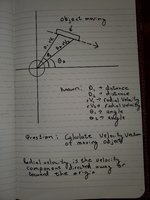JustinPaul
New member
- Joined
- Oct 29, 2020
- Messages
- 1
I am trying to solve this problem. I need the cars velocity vector (direction and magnitude). A car is traveling with a unknown velocity . We know the distance measured to the car from two different angles. We know the radial velocity of the car on both measurements. The radial velocity is the component of the velocity projected directly toward the origin. For example, if the car is traveling on a vector perpendicular to the ray from the origin the radial velocity is 0.
I have tried a bunch of stuff that does not work. I think the amount of change in radial velocity, change in distance, the angle between the measurements could create a ratio of some kind.
Any help or hints would be appriciated
thanks
I have tried a bunch of stuff that does not work. I think the amount of change in radial velocity, change in distance, the angle between the measurements could create a ratio of some kind.
Any help or hints would be appriciated
thanks

